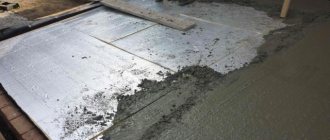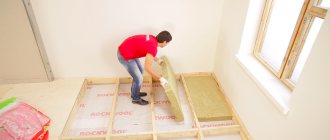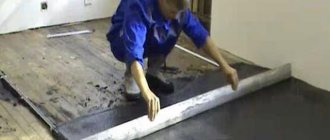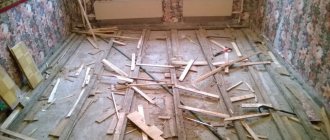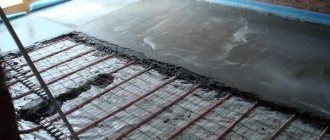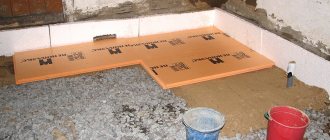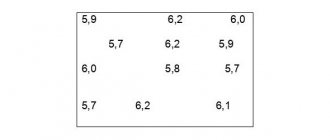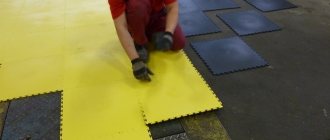Share with friends
Before you start choosing materials that can be used to insulate concrete floors under linoleum , it will be useful to dwell on the advantages of this coating. Main characteristics of linoleum:
- Fairly low price;
- Aesthetics and the widest selection of colors and patterns on the coating;
- Durability and abrasion resistance;
- Easy installation.
Despite the fact that today there is a wide selection of floor coverings made from various materials, from domestic and foreign manufacturers. Linoleum remains the most popular among consumers for finishing flooring in apartments.
Almost all types of coating have a backing made of vinyl or PVC foam, which provides protection from moisture and increases service life. This base provides additional sound and heat insulation, but often this is not enough. In this case, insulation of the floor is required by installing a linoleum underlay.
Base under linoleum
Before you begin laying the flooring, you must carefully prepare the subfloor.
Linoleum is elastic in its structure, and over time it repeats all the shapes of the base on which it is laid. Therefore, any base before installation must meet the following requirements:
- Durable and smooth surface;
- Solid subfloor;
- No traces of paint;
- No moisture or greasy stains.
Plywood base
Compliance with these conditions will help extend the life of the coating.
On a concrete base
Remember that laying linoleum on a concrete floor is carried out at a temperature not lower than 18C and a humidity not higher than 68%. Before laying, the floor covering is spread out, leveled, and time is given for the material to “settle.” Then they begin cutting the material.
The covering is laid out taking into account the location of the pattern, and a margin of 10 cm is left at the edges. After gluing the coating, the remnants can be carefully trimmed. All seams formed should be positioned away from the window in the direction of the light so that they are invisible. For installation you will need the following tools: roller, knife, ruler.
Preparing the concrete base
There are several options for laying linoleum on a concrete floor, which can be combined if desired:
- Without glue - the method is fast, used in small spaces;
- With adhesive tape - in this case, the linoleum is secured with adhesive tape, which extends its service life;
- Using mastic or glue is the most effective method of installation, and is necessary for large areas.
Installation with glue
The choice of installation option depends on the area of the room and the loads. But to avoid the formation of folds and waves, it is better to glue it. It is also determined in each specific case whether a substrate is needed for laying linoleum on a concrete floor.
On a wooden floor
A wooden floor can act as a base for decking. A linoleum underlay on a wooden floor is not required, since the floorboards retain heat well. Only the floor needs to be prepared before laying. Replace unusable boards, clean them, hammer in all protruding nails and seal all cracks and crevices.
Base wooden floor
After leveling, a primer is applied to the wooden floor, which creates a protective layer against moisture, insects and mold. After the boards have completely dried, you can begin laying the flooring material.
Sometimes plywood is laid on a wooden floor as an underlay for linoleum. In addition, plywood can thus hide all the unevenness of a wooden floor. The plywood is laid offset, cleaned, and the seams are sealed with putty.
Laying without underlay
Laying linoleum is the same as on a concrete floor. In the process, the question arises: is a backing for linoleum on plywood additionally needed, as insulation? Of course, it can be used as an additional measure to extend the life of the flooring material.
See which insulation is best to use under linoleum on a wooden floor. Usually these are soft and loose materials that easily take shape.
Linoleum on linoleum
It is possible to lay a new coating on old linoleum if there are no defects on it and it is impossible to remove it from the floor surface. In this case, the old coating will serve as an insulating layer.
Restoration of defects on old linoleum
If there are flaws or tears on the old coating, restoration is first required. After that, the surface is sanded with sandpaper and a primer is applied. Only after such preparatory work can new flooring material be laid.
For ceramic tiles
When laying linoleum on ceramic tiles, first clean the tiles of all contaminants and seal the seams flush with the tiles. After the leveling solution has dried, you need to polish the surface well, after which the final screed is done. After the screed has dried, the flooring can be laid. It is recommended to lay linoleum on a substrate to avoid sagging at the seams.
Screed on top of ceramic tiles
It is difficult to lay linoleum on glossy tiles. This will require significant financial and physical costs. Therefore, such flooring should be removed rather than covering it.
Problems
What kind of insulation can be put under linoleum
The market is replete with materials for floor insulation - natural, polymer. There are special heating systems operating from the network
When choosing a substrate, you should study its characteristics, and also take into account the characteristics of the room
Which one is better to choose for a concrete floor?
If there is concrete under the linoleum, it is better to give preference to hard material
This is especially important if it is also planned to lay concrete mortar on the insulation. In this case, the insulation should not absorb water and be vapor permeable.
Insulation and concrete solution
For wooden floor
If you plan to lay linoleum on wood, soft, loose materials that do not hold their shape are suitable
It is important that the insulator can “breathe” and allow water vapor to pass through. The wooden floor covering is made precisely so that the structure “breathes”
Is it possible to put insulation under linoleum?
There are types of linoleum already equipped with a thermal insulation layer. This material does not require additional insulation, but it is not cheap. It can be advantageous to purchase a conventional coating, to which an additional substrate is taken.
How to lay insulation with foil
The metallized coating reflects infrared radiation. Therefore, the insulation is laid so that the foil faces the inside of the room. The material is fixed on a flat concrete base with a special glue containing rubber.
The cost of an electric heating system ranges from 1,900 to 23,340 rubles. The price of a device is determined by its power, safety, and additional functions. The cost of the insulating substrate depends on the thickness of the material, technical characteristics, and manufacturer:
Floor insulation in a wooden house
Before the process of thermal insulation of the floor covering in a private house, it is necessary to select insulation. There are a huge number of similar products on the construction market, but the best materials for floor insulation are considered to be:
- mineral wool;
- penofol;
- extruded polystyrene foam;
- isolon;
- ecowool;
- expanded clay;
- wood sawdust.
It is not difficult to understand that sawdust is considered the cheapest type of thermal insulation. This material is obtained after processing wood using special equipment. This is a secondary product that is environmentally friendly and has minimal cost. In addition, sawdust can be poured into any cracks. A floor insulated with their help will be absolutely safe for human health.
The second most accessible and popular thermal insulation materials, mineral wool, are distinguished by good heat-insulating and sound-proofing properties. Such products are available in the form of mats or rolls. They do not burn under the influence of high temperatures; in addition, fungus and mold do not appear on their surface. The main disadvantage of the material is the loss of its original properties when water penetrates the structure. In this regard, mats must be protected from moisture with high-quality thermal insulation.
Such thermal insulation material as isolon is made on the basis of mineral fibers. Such products are characterized by low thermal conductivity, resistance to chemicals and biological factors. The insulation has an average cost and is resistant to mechanical stress.
And the last material, polystyrene foam, has high strength and resistance to moisture. Such products are supplied to hardware stores in the form of slabs and are distinguished by excellent thermal insulation properties. This material is quite durable, rodents and insects do not take it.
To insulate the floor in a wooden house, many people choose mineral wool. To carry out insulating work you will need the following tool:
- hacksaw or parquet saw;
- electric drill;
- building level;
- plane;
- drills of different diameters;
- hammer;
- sharp knife;
- roulette.
The entire list of works boils down to the following:
- Creating a subfloor from chipboards or boards, laying waterproofing.
- Installation of wooden bars (logs).
- Laying the selected insulation, in our case mineral wool.
- Installation of flooring.
At the initial stage of work, it is necessary to remove the old coating and correct unevenness on the base. After leveling the surface, a subfloor is created from waste softwood boards. The croakers are fitted tightly and then treated with an antiseptic. If you do not use the specified impregnation, the joists and wooden boards will rot after 5-7 years of use. All elements are fastened together using screws or nails.
At the next stage of work, a metal mesh with a small mesh size is laid on the rough coating. Next, this structural element is sprinkled with a thin layer of expanded clay (about 4 centimeters). This material will not only press down the mesh, but will also create the necessary ventilation gap between the insulation and the subfloor. Waterproofing, roofing felt or plastic film is also laid underneath.
Bars or joists are laid on the waterproofing of the rough wooden floor. They are attached to the surface every 80-100 centimeters using nails or self-tapping screws. One or several rows of mineral wool are placed in the space formed between these elements. The insulation is installed with overlapping joints, so that no gaps form between the slab and the joists. Next, the waterproofing is installed, which is attached to the base using staplers.
Milled boards are used as the finishing floor covering, connected to each other using a tongue-and-groove system. These elements should have the same thickness within 4...5 centimeters, while their width ranges from 10 to 13 centimeters. A special longitudinal recess is made at the bottom of the boards for air circulation under the floor covering. Where the boards adjoin the walls, a structural gap of 1-1.5 centimeters is left. In the future, this gap will be covered with a plinth.
Polymer
Insulation materials in this category are available at an affordable price. Artificial insulation has become popular due to its excellent characteristics and ease of use.
Polymers are presented in a wide range:
- expanded polystyrene - porous thermal insulation boards;
- thin insulation - a liquid composition that, after hardening, forms a porous coating 1 mm thick;
- penoizol is a special foam plastic that is fire-resistant and does not emit harmful substances;
- Rolled penofol - foil insulation with reflective properties.
We insulate with polystyrene foam
Suitable types of linoleum
According to popular belief, linoleum is a thin vinyl material that contains more chemical elements. But this is not true.
In total, today the construction market offers customers five varieties of this flooring:
- Natural. This type is an environmentally friendly material. It also has a huge service life and a high level of fire resistance.
- PVC floor covering. Most often, people buy this particular material because of its cheap cost. This type is not particularly suitable for heated floors. When the surface heats up, an unpleasant odor will appear in the room.
- Alkyd. This linoleum has a fabric base. Has excellent thermal insulation characteristics. However, there is a significant drawback - after a certain period of time, due to heating or mechanical influences, the product undergoes deformation.
- Nitrocellulose. It consists of one layer and has moisture-resistant characteristics. But there is also a minus - a low level of fire resistance.
- Rubber. It consists of two layers. The composition of this material includes bitumen, rubber, synthetics. Rubber linoleum is rarely used in residential buildings.
According to a brief description of all varieties of this flooring, not all are suitable for heated floors. The best option is the first type - natural. The use of vinyl linoleum (PVC) is allowed. Other types are not suitable for the heating system.
Let's take a closer look at the first two types.
Natural linoleum
If you can afford to buy it, then opt for it. This product contains only natural elements of nature, namely flax oil, pine resin, crushed cork, lime powder, and natural dyes. It follows from this that this variety, when heated, will not be able to release substances that could be harmful to human health.
This is the main advantage over other types, but not the last. Another distinctive feature is that the material is not deformable during heating or mechanical stress. "Marmoleum" has a high level of fire resistance. It can be exposed to direct sunlight, but natural linoleum will not lose its original appearance.
Linoleum PVC
Otherwise called vinyl linoleum. The natural look is not sold everywhere like vinyl flooring. Choose PVC if you are unable to find natural ones.
This type is divided into separate types:
- domestic;
- commercial,
- semi-commercial.
For residential premises it is recommended to use the last two types. Because they have a higher level of stability and a longer service life. Do not use a product that has a thermal insulating base, because it will serve as an obstacle to the penetration of heat into the room. Heating elements in this case will be useless.
The material must have a fabric base. Don't forget that the vinyl product is made of synthetics, so after the initial heating there may be an unpleasant odor. But after about a month it will disappear.
Might be interesting
What you need to know to choose the right one
Choice of linoleum.
When choosing this flooring, take into account the purpose of the room.
So, let's look at the types of linoleum:
- domestic;
- commercial;
- semi-commercial.
The household type of this material is used for residential premises, that is, where the surface will experience a slight wear load.
Commercial and semi-commercial types can withstand a large flow of people; they are used for public buildings.
Its performance properties depend on what insulating base is used for this coating.
Foam base
This base is used for multilayer linoleum.
Layers of foamed vinyl are applied to the supporting layer of fiberglass on both sides.
This structure gives it elasticity and softness, increases sound and heat insulation properties.
On the front side of the product, the printed design is protected by a transparent PVC layer.
It retains its beautiful appearance for a long time, this is facilitated by the use of technology for applying a pattern to the entire thickness of the layer.
This flooring is durable, easy to clean, practical, and not afraid of moisture.
Can be used indoors with heavy loads.
You can find out how to lay laminate flooring on our website.
What is OSB board? How can I use it to level a wooden floor? If you don't know all this, this article will help you.
Read here what you can put under the laminate: https://floordigest.ru/iskusstvennie-pokritija/laminat/kak-pravilno-klast-laminat.html.
Naturalness
Felt or jute is used as a natural base.
This coating is pleasant to the touch, it is soft and elastic.
Well suited for children's and bedrooms.
Do not use this type of flooring product where moisture may appear, because the natural substrate is afraid of rotting.
The top layer is not ready for increased abrasion loads; when choosing a floor covering, this fact is also taken into account.
Polyester products
The floor covering has proven itself well, where polyester is used as insulation - a white base made of synthetic fiber.
This material has good strength, heat and sound insulation characteristics.
Double base: foamed vinyl and polyester
The modern look of this floor covering combines two types of insulation - foamed vinyl, which gives the material additional strength and moisture resistance, and polyester, which enhances the thermal insulation properties of the coating.
The product is not afraid of temperature changes and can be used in periodically heated buildings.
Features of laying different materials
The peculiarity of the installation of various products lies in the requirement for the base. For all types of materials, the room must be kept clean and dry when laying. It is necessary to empty the room of furniture and dismantle the baseboards.
The wooden base should be treated with a primer with an antiseptic; visible damage to the boards and seams should be repaired with wood putty. Then the selected type of substrate is laid. A roll lining made of natural raw materials is fixed with the staples of a construction stapler.
If you decide to lay sheets of chipboard, OSB or plywood, you need to calculate the required material. Then the frame is assembled. The joists are attached to the floor with screws and self-tapping screws. The slabs are laid so that the joints are staggered. The sheets are screwed to the frame with self-tapping screws.
Installation of hardboard fiberboard is carried out using wood screws or nails without installing a frame.
Cork flooring requires a level base, so the flooring is initially leveled. Cork rolls should lie in the apartment for a couple of days so that the temperature and humidity of the substrate are equalized.
Waterproofing must be laid on the concrete screed (usually polyethylene is used) when there is an unheated basement below the room. Then the rolled cork backing is rolled out, the strips are fixed together with construction tape
To prevent damage to the cork, installation and subsequent installation of linoleum is carried out carefully and with care
The concrete base is leveled with a cement screed or self-leveling floor (with minor differences in height). Before applying the sand-cement mortar, the surface is treated with a primer. How long the screed takes to dry depends on the ambient temperature and humidity; in warm weather, you need to ventilate the room more often. The underlay should be laid after the floor has completely dried.
Penofol is spread with the foil facing up, the joints between the rows are sealed with foil tape.
Installing a rod-type infrared floor is too labor-intensive to install, so it is easier to choose a film version of a heated floor. You should not place thermal film under furniture, since infrared radiation heats surrounding objects. The thermo-reflective bedding is laid out and secured with tape. Then the IR film is spread out, connected into a circuit with clips, and the wiring is connected to the thermostat and temperature sensor. Floors can be grounded.
When is insulation needed?
Residents of the first floor of a city apartment know that even linoleum on felt does not always protect from the cold. Concrete and an unheated basement below lower the floor temperature. The same situation occurs in a private house with a concrete screed and an uninsulated foundation. Powerful heating does not solve the problem; it becomes too expensive and ineffective. The situation can be corrected by laying a special insulating layer that reduces heat loss.
Good insulation is not only a means of creating a comfortable indoor microclimate. The soft substrate is capable of absorbing household noise and acts as a sound insulator. In addition, the special material conceals minor unevenness in the floor. Installing rigid insulation is often preferable to pouring a leveling screed.
Types of materials for vapor barrier
Despite the same purpose, means intended to contain steam differ both in the components from which they are made and in their properties. Of the most popular, four groups of vapor barrier materials can be distinguished:
- Polyethylene film
- Polypropylene film
- Foil mats
- Diffuse membrane
Polyethylene film
The most budget-friendly type of vapor barrier protection. The thin film, which does not react well to sudden temperature changes, breaks easily, making it inconvenient for installation.
Peculiarities:
- Low cost;
- Requires a ventilation gap;
- does not allow air to pass through, thereby creating a “greenhouse effect” indoors;
- Weak strength. During installation, rupture easily occurs, sharply reducing the vapor retention rate;
- high flammability;
- breaks down at low temperatures.
Polypropylene film
It is a more practical analogue of polyethylene. At the same time, they are not significantly more expensive. It does its job well and is less susceptible to damage from temperatures, exposure to UV rays, and mechanical stress.
Peculiarities:
- Strength;
- In reinforced versions, one side is equipped with viscose or cellulose fibers that retain vapor and moisture;
- Similar to polyethylene films, requires a ventilation gap;
- average flammability indicators.
Foil mats
Rooms exposed to high levels of humidity and temperature, such as baths, deserve special attention. Temperatures sometimes reach 120 degrees, which can lead to melting and release of harmful substances from the above-mentioned materials.
In such cases, it is customary to use special vapor barriers. A layer of foil applied on one side not only prevents the penetration of steam, but also helps preserve heat: infrared radiation from the metallized surface returns inside the steam room. This type of vapor barrier is called “reflective”.
Peculiarities:
- foil-based insulation helps to further retain heat inside the room;
- tolerate high temperatures;
- depending on the base material, they may release chemicals;
- have low strength;
- The combination of foil and fiberglass is quite durable and has good thermal insulation properties, but is expensive.
Diffuse membrane
The most modern, durable and reliable method of vapor barrier with excellent vapor permeability indicators (up to 7 g per square meter per day).
The material was first used for the space industry, from where it gradually moved into the construction of ground-based structures. It is a sandwich of non-woven polypropylene and tensile reinforcement. Due to this, in addition to vapor barrier properties, it also has hydrophobic properties.
Separately, there are 3 classes of membranes:
One-sided. It is laid with a smooth layer to the thermal insulation, and a rough layer to the floor. This ensures vapor retention along with more efficient heat storage.
Double sided. The membrane is made of mirror-like layering of synthetic fibers, providing identical properties on both sides. Increases steam/heat insulation and simplifies installation. You can style it any way you like.
Intelligent. High-tech (three-layer) type of diffusion membranes. In addition to protecting floors from cold and fumes, it helps dry out the building structure underneath due to its structure. The absolute champion in the vapor barrier technology market.
Peculiarities:
- strength;
- durability;
- vapor control performance;
- the breathable structure does not require a ventilation layer at the “floor pie”;
- ease of installation.
How to lay the underlay: step-by-step instructions
After the lining for the new linoleum on the concrete floor has been selected, all that remains is to carry out the installation work.
The floor renovation process consists of several stages:
- Preparing the concrete base.
- Surface waterproofing.
- Installation of the lining.
- Fixation of the middle layer.
- Laying linoleum flooring.
Each stage has its own nuances, which must be taken into account when performing the work independently.
Preparation
First, you need to try to make the surface of the concrete as smooth as possible. All debris and tools are removed from the surface. Use a broom and vacuum cleaner to get rid of dust.
If the floor is level, you can immediately proceed to the second stage. If not, you will have to repair it. First, the concrete must be primed, then a screed will be needed to repair the damage, this will mask the defects and level the floor.
Well prepared base
If the damage is minor, repair will only be required in their areas. For this purpose, ordinary cement mortar or adhesive for laying ceramic tiles is suitable.
Waterproofing
This is an optional step, but in some cases it can significantly extend the service life of both the substrate itself and the entire floor structure. To check for moisture problems, you need to lay down a plastic film; moisture will accumulate in areas of evaporation.
The film will protect from getting wet
If possible, you should try to find a piece of waterproofing polyethylene that fits the area of the room. If you can’t find such a large canvas, you can glue it together from several parts using tape. It’s all simply laid on top of concrete, and fixation will be ensured by the following layers - substrate and linoleum.
Substrate
The main requirement for its installation is the most integral design. Linoleum is sensitive to various types of irregularities, and after a few years the joints of the lining strips will be noticeable. As a result, instead of leveling the floor, the litter, on the contrary, will make it crooked.
To avoid such a problem, everything must be done strictly according to the rules. Installation instructions using the example of a roll substrate:
- You need to buy a lining taking into account the area of the room plus a small margin.
- To get used to it, the material must be left unrolled for 24 hours.
- At the joints of the rolls, double-sided tape is used for fixation.
Unfolded synthetic backing
After this, you need to leave the material for adaptation for some time and then move on to the next stage.
Fixation
In order for the lining to be securely attached to the concrete base, it must be glued. For thin and light synthetic substrates, double-sided tape can be used. For heavier options, polyurethane-based adhesives are suitable.
Another fixing option is self-tapping screws. It is suitable in cases where waterproofing is installed under the substrate, but strong fixation of the structure to the base is required.
A video of the installation process will help you get acquainted with the nuances in more detail.
How to lay underlay on the floor
Laying linoleum
Before proceeding with the installation of the linoleum itself, you need to repeat part of the preparatory stage, namely cleaning the surface. Just as in the case of the lining, the linoleum needs to “rest” unfolded for a day in the installation room.
Flooring with reserve
Installation process:
- Linoleum is spread in the room so that its edges slightly “extend” the wall.
- In this position it is tracked.
- Fixation. Use glue or double-sided tape. In this case, either the entire canvas can be processed, or only the edges.
- The room is ventilated.
- Skirting boards are being installed.
A glue-free method of laying the coating is also possible. Then the linoleum is fixed only with skirting boards. The advantage of this option is the possibility of easy dismantling and maintaining the integrity of the coatings.
Preparatory and main work
No special tools are required to install the substrate. The first step before carrying out work is to clean the surface on which the material will be laid. To remove debris and dust, it is better to use a vacuum cleaner, after which it should be washed.
There is no additional need to level the floor under linoleum unless necessary, but if the surface has significant defects, then it is better to pour a concrete screed, which requires a leveling compound and a rule.
If the thermal insulation material is laid on an old wooden floor, then before carrying out installation work it is necessary to lay sheets of fiberboard or plywood on it and only after that lay the underlay under the linoleum. To avoid swelling of the fiberboard, a plastic film should be laid underneath it.
During the work being carried out, in addition to the selected and purchased insulation material, the following must be present:
- knife;
- scissors;
- masking tape.
In other cases, you may need plastic film, sheets of plywood or fiberboard, as well as screws and a file or an electric jigsaw.
If the installation of the linoleum underlay is carried out on a warm floor, then you need to acquire an additional thermostat and a temperature sensor.
When laying the underlay on parquet without using sheets of plywood or fiberboard, the first thing you need to do is scrape the sharp sides of the workpieces.
When installing insulation under linoleum on a concrete base, the installation must be done with precise placement along the length of the floor. In this case, the substrate must be cut into strips and laid. Basically, a floating method is used, during which the material is not fixed to the floor. The roll substrate must be laid on the surface of the base, joint to joint, using masking tape to secure the strips together.
Note! Natural insulation materials must be placed on the base only after preliminary laying of a protective film on it.
The application of heat-insulating paint should be done using a spray gun, roller or paint brush. The layer thickness should reach 1 mm. For a high-quality result, it is necessary to perform an autopsy three times.
You can lay linoleum after insulation a day later, but the joints of the substrate should not coincide with it.
Floor insulation with plywood
You can perfectly insulate the base by laying plywood over joists, which can be regular or adjustable. The latter are more comfortable to use when there are uneven surfaces on the floor. If they are insignificant, then it is enough to place ordinary logs, since the differences present can be removed by placing pieces of chipboard, OSB or boards.
Note! This solution is suitable for rooms with high ceilings.
If the concrete base has optimal evenness, then laying joists can be avoided, but only if the room is heated in the cold in winter.
Installation of a plywood floor is carried out as follows:
- It is necessary to lay logs on a concrete base, maintaining a distance of 40-60 cm between them. To fix them, you need to use dowels or anchor bolts, checking the levelness of the horizontal position using a building level.
- If the selected insulation material does not tolerate moisture well, then it is necessary to install waterproofing.
- At the next stage, insulation must be laid between the joists.
- Next, you need to cut the plywood into square pieces and lay them, observing small gaps between the sheets and near the walls, using self-tapping screws as fastening elements, the caps of which should be slightly recessed into the wood material.
- Upon completion of installation, it is necessary to cover the joints and heads of screwed-in fasteners with putty.
After completing the above steps, you can begin laying linoleum
It is only important before this to choose not only high-quality material, but also to familiarize yourself with how it should be laid
Having learned how to insulate the floor under linoleum, you will be able to choose the most optimal option from a number of available substrates and insulation materials, and then it is quite easy to install any of them with your own hands.
Video:
You may be interested in:
How to level linoleum from waves: leveling the laid and new material
How to sheathe the inside of an attic for housing: choosing the right material
How to sand a wooden floor before further application of paints and varnishes
Problems
What kind of insulation can be put under linoleum
The market is replete with materials for floor insulation - natural, polymer. There are special heating systems operating from the network
When choosing a substrate, you should study its characteristics, and also take into account the characteristics of the room
Which one is better to choose for a concrete floor?
If there is concrete under the linoleum, it is better to give preference to hard material
This is especially important if it is also planned to lay concrete mortar on the insulation. In this case, the insulation should not absorb water and be vapor permeable.
Insulation and concrete solution
For wooden floor
If you plan to lay linoleum on wood, soft, loose materials that do not hold their shape are suitable
It is important that the insulator can “breathe” and allow water vapor to pass through. The wooden floor covering is made precisely so that the structure “breathes”
Is it possible to put insulation under linoleum?
There are types of linoleum already equipped with a thermal insulation layer. This material does not require additional insulation, but it is not cheap. It can be advantageous to purchase a conventional coating, to which an additional substrate is taken.
How to lay insulation with foil
The metallized coating reflects infrared radiation. Therefore, the insulation is laid so that the foil faces the inside of the room. The material is fixed on a flat concrete base with a special glue containing rubber.
Prices
The cost of an electric heating system ranges from 1,900 to 23,340 rubles. The price of a device is determined by its power, safety, and additional functions. The cost of the insulating substrate depends on the thickness of the material, technical characteristics, and manufacturer:
| Type of canvas | Price range per sq. m |
| Cork | 95-140 |
| Coniferous substrate | 160-180 |
| Izolon | 16-40 |
| Foil backing | 50-100 |
| Expanded polystyrene | 45-240 |
Often, linoleum is already supplied with a thermal insulation layer during manufacturing. However, additional insulation is still desirable. A layer of thermal insulation makes staying in the room more comfortable and improves the sound-absorbing ability of the floor covering.
Did the article help you? (7 ratings, average: 2.86 out of 5)
Famous manufacturers
Insulated linoleum from several companies is sold in the markets of our country. Let's list the most popular ones.
Tarkett
This manufacturer is a leader among companies involved in the creation of flooring. It has been producing a wide variety of flooring surfaces since the beginning of the 20th century. The quality of the product meets not only domestic sanitary standards, but also European ones. The company produces both felt-based and foam-based products. In addition, all material has a high fire safety class.
Linoleum Tarkett
IVC
This manufacturer produces its products in Belgium. His product has excellent characteristics and a unique design, so a room with such a floor looks very chic. Thermal insulation is provided in this case by felt. Therefore, the surface will not only be soft and warm, but you can also walk on it barefoot.
Linoleum IVC
Forbo
This company specializes in the production of eco-linoleum. Its products contain about 97% natural ingredients. One of the company's lines creates a cork-based coating. It not only perfectly prevents heat loss, but also blocks sounds. Other lines use jute for thermal insulation.
Linoleum Forbo
"Comitex Lin Parma"
The specialization of this enterprise is to create economy-class household coverings. The insulation in this case is felt. This linoleum is well suited for temporary housing or a summer cottage. Its price allows this.
Linoleum Komitex Lin Parma
Chipboards
Insulating a concrete floor using pressed slabs is a three-layer “pie” consisting of waterproofing, chipboard and a finishing coating. Please note that the insulation is installed exclusively on a dry, clean surface covered with plastic film (waterproofing).
A small gap (1.5 cm) must be left between the wall and the slabs. This will help maintain the integrity of the structure during linear expansion of the material, because chipboard boards change their dimensions with temperature changes.
The insulation is attached to the base of the floor with dowels, and the joining seams are glued with a special construction mesh, which is coated with a composition of sawdust and parquet varnish in a 1:1 ratio. At the final stage, the decorative covering is laid and the plinth is attached.
The easiest way
For lining a concrete base, a material with a thick lining is suitable.
If you need to cover a concrete floor base, characterized by its cold surface, in the shortest possible time, the best option would be to use linoleum with glued insulation.
This coating consists of 2 layers. The top one is decorative, made of high-quality PVC coating, the bottom one is a heat-insulating lining.
Felt also serves as a floor leveler
The first layer is usually no more than 2 mm in thickness and is very elastic. In addition, it has an increased service life and ease of maintenance.
The inner layer, made of felt or rope no more than 5 mm thick, serves not only to insulate the cold base, but also plays the role of an excellent leveler for small surface defects.
The disadvantage is the inability to glue such a coating without compromising the heat-insulating properties.

